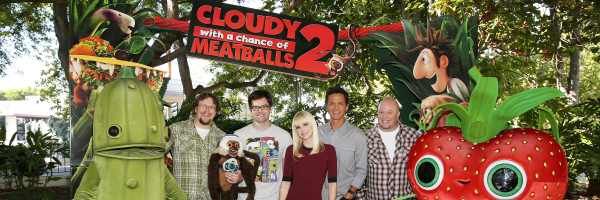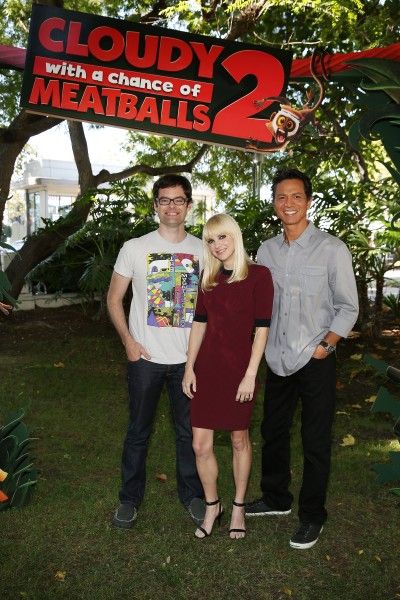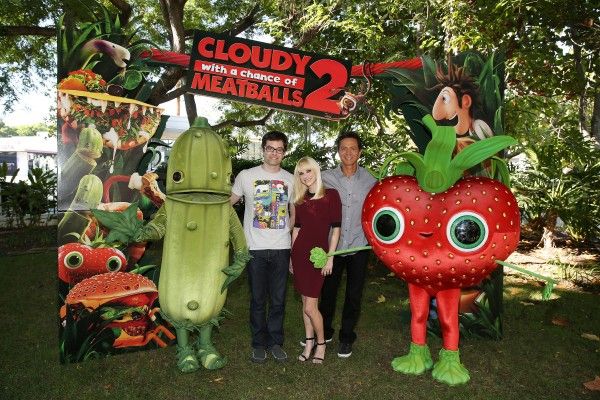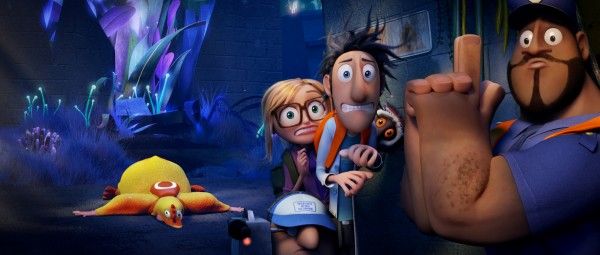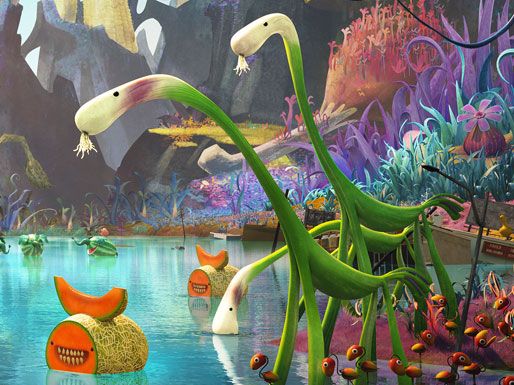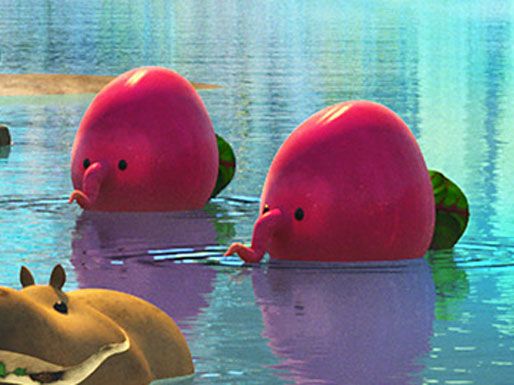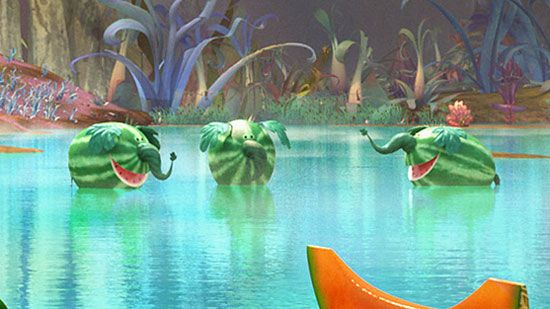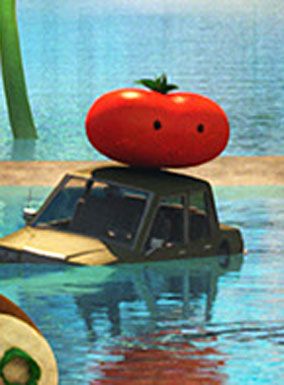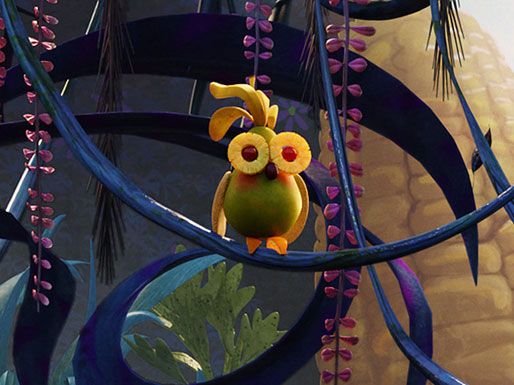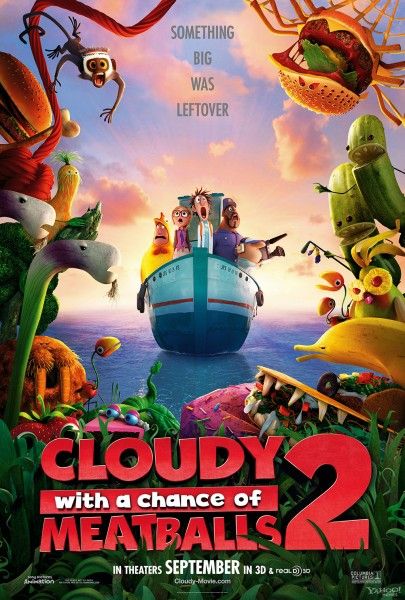Recently I was invited to take an early look at Cody Cameron and Kris Pearn’s hilarious new animated comedy, Cloudy with a Chance of Meatballs 2, at Sony Pictures Animation Studios. The co-directors, who were story artists on the first film, took the reins from Phil Lord and Chris Miller who remain onboard as producers. Cameron and Pearn’s enthusiasm was obvious as they presented some very funny clips and cool footage from the sequel which picks up sixty seconds after the 2009 hit comedy ends.
The plot revolves around what happens after the island of Swallow Falls is evacuated to clean up the food disaster from the first film and Flint (Bill Hader) discovers his infamous invention is still active and churning out mutant food animals. He and his friends set out on a dangerous mission to save the world from adorable but deadly food monsters that include ravenous double bacon Cheespiders, Tacodiles, Shrimpanzees, Apple Pie-thons, Flamangos, Bananostritches, Fruit Cockatiels, Mosquitoast, Watermelophants, Wildebeets and more. Check out a recap of the day's presentations and an interview with Cameron and Pearn after the jump.
During the presentation and roundtable interview, Cameron and Pearn discussed the creative ways they’ve expanded the story and characters without losing the heart that made the first film so great, why they decided to flip genres, the new designs they came up with for the food creatures, how technological advancements allowed them to do things stylistically that weren’t possible before, and their cinematic inspirations including Jurassic Park, Return of the Jedi, Teen Wolf, and E.T. They also revealed how the actors convey their comedic work in an animated form with split screen footage showing their performance in the recording booth and how it’s transformed into the finished scene.
The animated sequel revisits the original characters and introduces colorful new ones in a crazy new adventure that promises to be just as enjoyable, heartfelt and funny as the first film. Based on what I saw, it’s imaginative, visually inventive and should look stunning in 3D. It’s also filled with clever puns and the food has never been funnier. This is one movie I’m definitely looking forward to seeing when it opens September 27th. The interview follows below:
How long is the process from inception to actual release?
Cody Cameron: This one was three years.
Kris Pearn: Yes, September will make…actually August. No July. Did we start developing in July?
Cameron: It’s been a fever dream. My kids are three years older so that’s all I know. But basically three years. It was maybe a year of story development and we started getting into the script, and the design, and all that.
Pearn: The first film, to put it in perspective, I was on story in the first film for four and a half years, and then the movie came out about 8 months after we pulled off the story.
Cameron: I think I joined maybe a year or two after you did, and we were both on until the end.
Pearn: It was probably in development a year before I got on it. The average, I’d say for a new idea, you could probably look at what? Six, seven, eight years?
Cameron: Yeah.
Pearn: That’s not unheard of, but the actual production time on this was three years.
So you’ve been doing Cloudy for a decade now?
Pearn: It’s crazy. It is. We both worked on projects in between so we did have a palate cleanser. I went over to England. I was working on the Aardman projects and you were directing Open Season.
Cameron: Yes. Open Season 3.
Pearn: It was good to take a break, and there was a little bit of that, “Oh I don’t know if I can do it again” and then we walked into the room and we just started playing with Chris (Miller) and Phil (Lord) and doing the story what if, and it got really fun very quick and if felt like the old times. It was a very natural beginning to get back into this.
Cameron: And a lot of the ideas were left over from the first film. We had all of the sentient food stuff. There were longer scenes that we had boarded and so it was great to pull some of that.
Pearn: We had an itch to do a different genre.
Do you guys operate like Disney where the story guys have to come in and act out the storyboards, so it’s like a pitch but you’re acting?
Cameron: Yes, we do. We’re both board artists and (to Pearn) you were head of story on the first film, and also we storyboarded on this film as well. So we were with our story crew drawing scenes.
Pearn: We’re visual people so that’s how we communicate.
Cameron: We pitched the sequences. We usually pitch to the executives and then it gets cut by editorial, so we still do the song and dance.
Pearn: Back in the old days, when we started on Cloudy, we were still pinning things on the wall with a stick, and by the end of Cloudy, we were sitting with a computer and just doing that. There has been an evolution that’s just because of technology. The pipeline is digital now so you just draw on a computer and hit a button and it goes. You spend $5,000 to replace a sketch book. It’s all pipeline related. Everything is all digital now, but we still operate in that old way.
Cameron: I still draw on paper first and scan it in, and then use the Sentic after that.
Pearn: That’s how we end up with a lot of voices in these movies too, because we get used to doing the characters and cel the characters and quite often you just keep the character.
Was there any fruit or vegetable that just didn’t work?
Cameron: In the first film, they couldn’t model broccoli or they couldn’t render it to look like broccoli.
Pearn: It looked bad.
Cameron: And so, we made it look good, and I think popcorn had the same issue.
Pearn: On this film, there wasn’t anything that didn’t look good, but there was a tyrannosmaurus mess that was like a T-Rex Smore monster that was in a scene where they were crossing a crumbly glacier and that scene got cut from the film so that monster left. But it had a marshmallow body, a graham cracker mouth with chocolate teeth, and it would breathe fire to carmelize the crust.
Cameron: It had this whole ecosystem.
Pearn: Of course, my own kids were like, “Crème brulee glacier? What’s crème brulee?” That became a story problem. We had to explain first what crème brulee is to America.
Have advancements in technology allowed you to do things stylistically on this film that weren’t possible on the previous one?
Pearn: Certainly. We always talk about this concept that our production designer came up with the digital team over here called depth styling. The first film had a very graphic look. We were looking at Sasix children’s books. That was sort of our cue. And we were able to achieve that digitally. Knowing that we were going into an organic space this time, we wanted to figure out a way to make something look real when it’s close to the camera, but as it gets further away, it starts to feel like a painting. And so, the texture would reduce actually as we get farther away from the camera.
Cameron: In fact, when your camera moves away from the object, it flattens out and becomes much like a matte painting, so there’s less ones and zeroes to render. And then, if you move forward, it becomes a 3D object again.
Pearn: I know this sounds like it’s not that big a deal, but for us, when we got our digital team over here, they do real amazing [work]. We said, “Can you make it look like a painting?” and they were like, “We can do that.” And they went off and they developed this technology and it just almost made me want to weep. Every time you see it, it’s so pretty just how it comes in and out of focus, so that’s one of the things you probably wouldn’t pick up in the movie, but if you watch for it, it’s all over the film, especially in our jungle where we have no sky in a lot of our jungle scenes because the canopy fills up and our sense of depth is really created through this technology.
Is the film going to be in 3D?
Cameron: Oh yeah. Like most films, there will be 3D screenings and non 3D.
Pearn: But Cloudy 1 was the first film that we made here at SPA (Sony Pictures Animation) that we actually integrated our 3D into the story department. We certainly carried that through in this film. We’re very careful with our 3D. It’s done at the same time as we’re putting in our 2D cameras, so we’re always thinking about the composition.
Since the scope of this one is so much bigger than the first one, how do you guys story-wise try to keep the heart that made the first one so great?
Cameron: The characters are the most important thing.
Pearn: Beyond the hook of knowing that we wanted to do a monster movie coming into our second film, we also started thinking about what does Flint (Lockwood) need to go through. What can we do to him? So the first film, he started the film like maybe 8 years old and maybe we take him to emotionally 14 years old where he kisses a girl, starts to take responsibility for things, make some friends, but he’s still in his pre-pubescent phase. In this film, we wanted to graduate him into high school. That was one of our touchstones. It’s like Flint’s journey. We wanted to take him out of being the only weird kid and put him in a bigger place, and what happens to that guy as he starts to be accepted and starts to find out who he is in a bigger world.
Cameron: And how he’s going to hold onto his old friends when he’s making these new friends.
Pearn: I think it works, the kid logic of it. My kids are going into middle school now. What’s that called? Junior High? Like Degrassi. (laughs) I’m kidding. The graduation is a very common theme that every kid goes through, so we wanted to ground Flint that way. As we grounded him there, it allowed us to ripple through all the other characters. So like Tim’s relationship with his son, in the first film he was not very communicative. He didn’t know how to relate to his son. We popped that bottle in the first film. So now he’s always hugging his son and always with him.
Cameron: They’re a little overly affectionate.
Pearn: They’re in a one bedroom apartment in San Fran Jose and Flint is trying to leave his dad behind because he’s trying to figure out his own way. We’re very careful to not make Flint unlikeable, but there’s that storyline, that idea of separation, and so Tim ends up bonding with the product of Flint’s creativity which are these pickles. It’s like a grandfather-grandson story.
Cameron: Tim was the only one who liked sardines on the island, and he likes fishing, and Flint isn’t into those things. He finds these pickles that for some weird reason love sardines. He takes them fishing. They’re like adopted grandchildren.
Pearn: And certainly with Sam (Sparks), he validated her by making her feel smart in the first film. So, in this film, it’s about what happens when he starts to treat her like a weather girl.
The foodimals are so cute and they speak these weird little languages. How did you find their unique personalities and characteristics?
Pearn: We tried to locomote our food creatures in their own way. Like the cheeseburger and the idea that it has french fry legs. We didn’t jump on spider. We were drawing this 8-legged thing and we were calling it the Cheesetiger, and then one day somebody said it looks more like a spider. So it was great. It was like the idea of locomotion and sound, those two things, we tried to organically find that from what the creature is.
Cameron: And with the pickles, figuring that they are cucumbers that are brine, they probably live in brine pools, and so, since they’re wet, maybe when they speak, they have that residual gargle in the back of their throat.
Pearn: They’re moist. They’re a moist people, the pickles.
Cameron: We had a scene that was cut out of the movie where Tim becomes one of the pickles. He gets brinemitzvahed. He got thrown in a brine pool and he’s actually got kind of a green tint to him. He became the pickle king. It got a little weird.
The idea of pickles liking sardines is just so out there, I’m just wondering how on earth that idea came to you guys? What brought this on?
Pearn: There was a natural evolution. Originally, the pickles were being hunted by the cheeseburgers because they were hunting their condiments. And then, that idea got a little bit complicated because there were a lot of ideas in the movie as there always are. We knew we wanted to have Tim bond with the pickles, so the idea that the pickles…
Cameron: In fact, in the drawings, there was a scene that’s not in the film where Tim saved the pickles from the Cheesespider. In the end, we didn’t want to kill a Cheesespider and this scene went away. He still has a moment where he meets the pickles in a taco shop.
Pearn: Knowing that we wanted to have this kind of grandfather-grandson relationship, there’s a certain thing that happens when you have that non-competitive removal of family. Flint never knew how to fish. Flint never played baseball. Flint never liked sardines. Flint never got into the things that Tim got into. Tim’s big story point in the first film is that he likes sardines, so imagine that these grandkids like sardines. It just became a very natural bonding moment for the two of them. So, without the Cheeseburger attack, we now have the pickles that try to mug him for sardines. And he’s like, “You guys want sardines? I’ll teach you.” These are like little street kids and he’s going to civilize them and teach them how to be like real boys, boy pickles.
When you made this film, how did you approach those 3D moments without making them look gimmicky?
Cameron: We call it looking into the shoebox or a diorama where you’re looking into the space, and we do have occasional moments where a character will gesture and it will just happen naturally that their arm should come out into the audience, so we do a few of those. Or there are fishing rods that are coming at Tim almost like spears, so those come into the audience. But for the most part, we like the look of when you’re actually looking into a space rather than just the gag of a lot of stuff coming at you.
Pearn: A lot of the 3D technology that everybody’s using right now was actually started here at Columbia Pictures and Sony, and there was a whole team at Imageworks going back ten years ago that was behind that technology. So, we benefit from their knowledge that if you play the shoebox, like Cody’s saying, it’s easier for an audience to watch. It makes it more comfortable and it becomes compositional as opposed to gimmicky.
Is it like you’re listening to a window out at something?
Pearn: Yeah. It’s almost like a live action mentality where when you shoot a scene, you’re shooting the 3D at the same time as you’re shooting the 2D. When I was working on the Aardman films, like The Pirates thing, they would have the set and the camera would literally go over and take a shot and come back anytime the animator took a thing. So your set became the 3D space as opposed to the 3D coming always out at you. Certainly, we do have a couple of gimmicks like Cody said, but we’re trying not to be abrasive with it. Hopefully, it’s within the composition of the story. And I don’t think we have any 3D jokes in the movie. It’s mostly compositional.
How did Terry Crews become involved?
Cameron: Well, our casting director reached out to him. It was unfortunate that Mr. T didn’t want to return, but Terry Crews does a great job as Earl. He was into the idea, and he and his family had seen the movie. They went to the premiere. He was into the film. He came in and we told him not to do a Mr. T impersonation, but to be the character, to be Earl. What’s great is he almost does sound like Mr. T.
Pearn: The cool thing is Mr. T called him up and he passed the torch and said he would do a great job. We don’t know what the exact reason was, but Mr. T wasn’t in the head space to do it. It turned out to be awesome for us to be able to evolve the character in a new way, and actually Terry brought a lot to the table. He’s just so fun to work with.
Cameron: He’s a really nice guy and fun to play with.
Pearn: We were at Comic-Con and he walked onto the stage and the way he played that crowd was so amazing.
I talked to him at Comic-Con and he said it was the greatest thing for him to do this movie.
Cameron: Yeah, he’s awesome.
Benjamin Bratt said earlier that he’s doing this again.
Pearn: The nice thing with Benjamin is that Manny (Bratt’s character) talked in the first film, which was a great surprise, but now we get to use him more in this film.
The last movie was more of a take on disaster films and you said this is more of a monster film.
Cameron: But a monster/noble savage.
What were some of your cinematic inspirations?
Cameron: Well Jurassic Park was the big one obviously, because we have a watering hole with a Richard Attenborough of Chester’s beard and the Laura Dern outfit that Sam (Neill) is wearing. There are 80’s movies galore that either we do exact jokes to or it’s just homage. There’s Return of the Jedi. There’s some Goonies, a little bit of that, E.T. and Gremlins. There’s definitely some Teen Wolf in there. There’s the Lucas and Spielberg of the 80’s which could go to Joe Dante and Richard Donner. All those movies that we grew up watching and loving.
Pearn: Honestly, when we started Cloudy 1, for the first two months, we sat in a room and watched Irwin Allen movies from the 70’s and Roland Emmerich films from the 90’s. We were trying to find a world in between those two. At the same time, we were watching Jaws and Jurassic Park and taking those cues. We wanted to do some of that in the first film but we just didn’t have room for it. There’s some of the vestigial stuff there with the gummi bears and the pizza slices and what have you, but the idea of coming back to do another Cloudy movie, the first thing we had on the table was the genre. Let’s flip the genre and do a different story.
Did any of the actors get to record together?
Cameron: Not on this film.
Pearn: Everybody is scattered. Bill (Hader) was in New York and Andy (Samberg) was for most of the time.
Cameron: We went to Nebraska for Will (Forte). He was shooting the Alexander Payne film so we actually flew out one weekend to record him out there.
Are there more Meatballs in the forecast?
Cameron: Don’t know. It’s hard to say.
Pearn: I don’t know if we can say. I know two guys who are going to sleep after this movie for a little while.
Are the voice talent under contract should there be another one?
Cameron: I don’t know.
Pearn: We actually don’t know. We do the spaghetti on the wall stuff.
There are so many great moments of subtle humor in the first movie. Can we expect more of the same in this next one?
Pearn: Hopefully. A lot of the same story team is back and Chris and Phil were involved right from the beginning. I mean, we had the same process. That’s always a challenge to try to find those layers of jokes.
Cameron: And we do have puns that hit you over the head, but hopefully there are some more subtle ones.
Pearn: Some quieter ones.
Cameron: Some subtle comedy.
Pearn: And certainly, the animators bring a lot to the table, too. They were a big part of what made the first film really funny. And we have all our leads back in it.
Cameron: There’s some good physical comedy in it.
Pearn: You can tell 300 people we’re looking for jokes. You put the hunt out on them.

